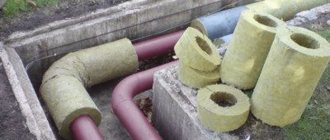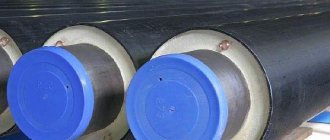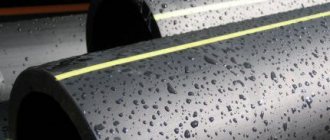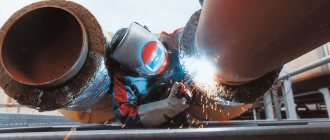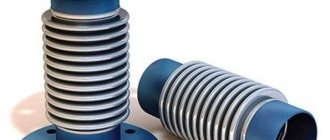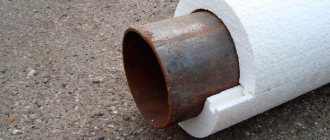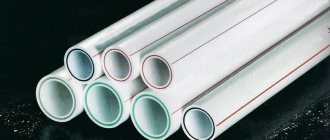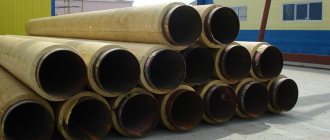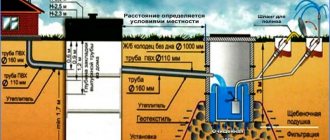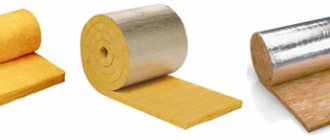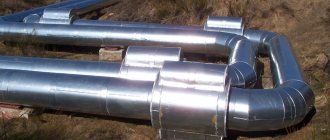How to insulate pipes in the basement with your own hands
Insulating a pipe with mineral wool with your own hands
Insulating a pipe with mineral wool
Stage 1
For plastic heating pipes, it is best to use mineral wool or glass wool. Take a roll of cotton wool, unwind it and cut off small pieces. Wrap it around the water pipe and secure it with a nylon rope. To do this, wrap and tie a rope on one side of the pipe, and in a spiral, wrap it all the way around the pipe and tie the rope securely - this is the initial insulation.
Stage 2
Waterproof the water pipe. To do this, take a roll of roofing felt and cut small pieces of 2-3 m each. Wrap the heating pipe around the top of the insulation. Try to make overlaps of at least 10 cm. Take the nylon rope again, tie it at one end and also wrap it around the heating or water pipe in a spiral. Additionally, the insulation can be wrapped with tape.
Pipe insulation with polystyrene foam
Pipe insulation with polyurethane foam
Take a polyurethane foam “shell” and connect the two halves around the pipe, wrap the edge with tape. Place the following parts “overlapping” by about 10-20 cm. Wrap the shell with tape at the junction. The insulation may have a layer of foil, which makes it similar to a thermos. This insulation can be used in the basement and outdoors.
Pipe insulation with polystyrene foam
Insulation with polystyrene foam is the most affordable material. Expanded polystyrene “shells” are produced for different pipe diameters; installation is easy and at the lowest cost. Take the insulation halves, connect it around the pipe and wrap it with tape. Carry out this operation until the entire pipe is covered with insulation.
We insulate heating pipes in the attic and basement
House heating costs are increasing every year. Each owner is looking for ways to save: the boiler turns on periodically, or constantly works only at a minimum, and so on. The use of such methods leads to a significant decrease in the temperature in the house. But few people think about how efficiently the living area is heated, because most of the heat is lost on the way to it. If heat loss can be minimized, then the rooms will warm up better and faster; therefore, continuous operation of the boiler will not be required, and it will be possible to resort to savings without compromising the temperature. Since boilers are often located in basements and other utility rooms, we will consider how to insulate heating pipes in the basement and other possible places where the system passes.
Foam plastic for pipes in the basement
The insulation technology depends on the choice of a specific material, which is selected depending on the conditions under which it will be used in the future. The most basic difference between basements and other possible places for pipes to pass is the high level of humidity. Therefore, it is necessary to choose a material taking into account this important feature.
It is best to insulate heating pipes on the ground and basement floors using polystyrene foam, foam glass, penoizol or expanded polystyrene. This group of insulation materials has the lowest moisture absorption rates. Among the materials mentioned there are both budget and more expensive options.
Before starting insulation, the surface of the products must be thoroughly cleaned of rust and dried from moisture. It is advisable to cover the elements with protective agents - a special paint that can withstand high temperatures. After this, you can begin to attach the insulation to them. You should start either from the beginning of the element coming out of the wall, or from the junction of two elements at a right angle. The insulation segments have a basic connection system with each other - a tongue and groove.
The first half of the insulation is applied to the pipe, and then the second half is applied and secured. The material is easy to cut, but does not bend. It will not be difficult to adjust the dimensions of an excessively long segment to the required ones, but to insulate the corners you will have to cut out rings with different side widths.
Glass wool for pipes in the attic
Unlike the previous location of the pipes, high humidity is rarely observed here, which is explained by strong ventilation. Complete insulation of attic spaces is not yet common. That is why the distinctive feature is high levels of sub-zero temperatures.
The choice of material should be determined by its thermal conductivity, as well as the ability to connect segments without the risk of forming cold bridges. Based on this, it turns out that insulation of heating pipes in the attic is best done using glass wool, slag wool, stone wool and basalt wool.
The products are sold in rolls, which is convenient for working with pipes. In addition, joining the edges of the sheets overlapping allows you to avoid the formation of weak points in the insulation. Cheaper options are used if the region of residence has mild winters. Otherwise, you should turn your attention to higher quality and more expensive materials.
Before starting work, you should clean the elements from dust, debris and dirt. It is advisable to coat them with radiator paint to protect them from rust. When working with this material, you must use gloves, a respirator, safety glasses and a robe that covers the entire body. The material is cut into sheets, the dimensions of which depend on the diameter of the pipes, as well as the number of layers of wrapping. It is advisable to wrap each section of the system at least twice. The edge of each subsequent canvas overlaps the edge of the previous one. Next, clamps are put on the insulated heating pipes. They are tightened at the joints of the canvases, securely fixing them in place.
Foiled foam foil for outdoor pipes
The passage of heating pipes on the street greatly affects the decrease in temperature in the house. In addition, areas of the system located in the open air quickly deteriorate due to constant exposure to adverse weather conditions. Therefore, insulation of heating pipes on the street should be carried out using materials with the lowest thermal conductivity and moisture absorption.
In order for insulation to last as long as possible, they must be closed. For these purposes, a waterproofing membrane is most often used. Insulation in this case is carried out mainly using foamed polyethylene or polyurethane, as well as foil foam. The highest quality insulation with the longest service life will be done using heat-insulating paint. This material is several times superior to other options in its properties.
The surface of pipes located outside must be thoroughly cleaned before insulation; this step is especially important for elements that have been installed a long time ago. Next comes the process of painting this section of the system, and it is necessary to apply paint for radiators in two or three layers. After it dries, insulation segments are installed. Its inner diameter must exactly match the outer diameter of the pipes. This material is laid in exactly the same way as the foam plastic considered. The final step will be to wrap several layers of waterproofing membrane around the insulated element. Its canvases, just like when wrapping glass wool, are overlapped. Then clamps are installed in these places.
Insulating heating pipes with your own hands is quite simple. You don't need a power tool. It will only be expensive to purchase materials that will pay for themselves in the first heating season. And changes in the quality of heating of residential premises will be noticeable immediately, since the heat will not be wasted.
Insulation materials and requirements for heating systems
List of materials used for thermal insulation of pipelines:
- mineral wool;
- expanded polystyrene;
- penoizol;
- foamed polyethylene;
- polyurethane foam;
- penofol.
Not only the main main pipelines are subject to insulation, but also the heating pipes of private and apartment buildings located in the basement, cellar, roof, street. Modern insulation materials are developed from inexpensive materials, with an ergonomic design that helps process pipes without the help of professionals and special tools.
Insulation for heating and hot water supply pipes - material requirements:
- Low thermal conductivity.
- Safety for humans and the environment.
- Inert to acids, alkalis and other biological substances.
- Non-flammable material.
- High melting point.
- Low hygroscopicity.
- High corrosion resistance.
- Durability.
- Economical.
- Easy installation.
Requirements for materials for insulating water pipes
Consumer requirements for insulating materials primarily take into account the ease of installation and long service life.
These requirements include:
- Water-repellent characteristics of the insulation material, increasing its tightness;
- Fire safety when using the material indoors, as well as the ability of the material to self-extinguish;
- Duration of service life of the material;
- Convenience and ease of installation, preferably with the possibility of repeated use;
- Reasonable cost of material.
In addition, a number of technological requirements are imposed on insulating materials for pipes, depending on their technical and operational characteristics:
- Low thermal conductivity and high heat-saving characteristics;
- Water absorption, which directly affects the destruction time of the material;
- Resistance to chemical and biological external influences;
- Operating temperature without additional insulation device.
Having understood the basic properties of insulation materials and the placement of water supply pipes, you can begin to select the specific, most suitable insulation for pipes: the main types.
Why do you need insulation for attic ventilation?
The ventilation system is designed to maintain a certain level of humidity and temperature in the room. It also needs insulation. This is especially true for the attic in winter, when the pipes are very hot from the inside and are blown with cold air from the outside.
Then condensation appears on the surface, which can damage the material. Proper insulation will reliably protect the structure and prevent negative consequences. This applies not only to pipes, but to the entire ventilation system as a whole. In addition, it will help save energy, which is also an important factor in favor of insulation.
PPU insulated pipes
The need and advantages of chimney pipe insulation
Condensation does not form in an insulated chimney, so the materials last longer
When building their own mansion, many owners of land plots underestimate the role and importance of communications for the removal of gases released during the combustion of fuel. By leaving a pipe exposed to the environment, they risk the loss of real estate and their own lives.
An insulated chimney pipe is a necessity based on the following factors:
- The pipe gets very cold in the winter cold. Heating it takes a large amount of energy, which entails a decrease in coolant temperature and increased fuel consumption.
- The difference between the internal and external temperatures of the pipe walls leads to the formation of condensation. When mixed with smoke, it forms a caustic substance that will corrode even stainless steel.
- Solid particles of combustion products settle on the moisture formed in the channel, which leads to the appearance of solid deposits. The draft deteriorates, the risk of complete blockage of the pipe and smoke in the room where the boiler is installed increases.
- The dew point is low because the gases leaving the furnace cool quickly. An insulated chimney does not have a dew point as such, because its temperature is the same throughout, and the internal walls do not come into contact with cold air.
- Brick channels are the most vulnerable. Moisture is absorbed into the brick, and when it freezes, it ruptures the material, causing slow but steady destruction of the entire structure.
If you insulate the chimney immediately after construction, the performance of the stove will increase and the safety of the inhabitants of the house will increase.
Laying pipes below freezing depth
This method is advisable to use if in winter the soil freezes no deeper than 170 cm. A trench is dug from a well or borehole, the bottom of which is 10-20 cm below this value. Sand (10-15 cm) is added to the bottom; the pipes are laid in a protective casing (corrugated sleeve), then covered with earth.
To avoid having to insulate the outdoor water supply in cold weather, it is better to do this in advance
This is the easiest way to make winter water supply at the dacha, but it is not the best, although it is the cheapest. Its main drawback is that if repairs are necessary, you will have to dig again, and to the full depth. And since it is difficult to determine the location of a leak with this method of laying a water pipeline, there will be a lot of work.
To ensure that there are as few repairs as possible, there should be as few pipe connections as possible. Ideally, there should be none at all. If the distance from the water source to the dacha is greater, make connections carefully, achieving perfect tightness. It is the joints that leak most often.
Choosing a material for pipes in this case is not the easiest task. On one side, a solid mass presses from above, so a strong material is needed, and this is steel. But steel laid in the ground will actively corrode, especially if the groundwater is high. The problem can be solved by properly priming and painting the entire surface of the pipes. Moreover, it is advisable to use thick-walled ones - they will last longer.
Even if the ditch was dug below the freezing level, it is still better to insulate the pipes
One more thing. The depth of soil freezing in the region is determined over the past 10 years - its average indicators are calculated. But firstly, very cold winters with little snow occur periodically, and the ground freezes deeper. Secondly, this value is the average for the region and does not take into account the conditions of the site.
You might be interested in reading “How to make automatic watering“.
Recommendations from experts
When choosing a suitable material for thermal insulation of a ventilation system, consider:
- The thermal conductivity coefficient should be as low as possible.
- Moisture resistance. The loss of insulating properties due to moisture absorption can nullify all the advantages of the material, including the low price.
- Difficult to install. The cost of specialist services depends on the danger of the material and the characteristics of its fastening. Insulating with cheap insulation can end up costing more than the highest quality insulation. If the work is supposed to be done independently, then the investment of time and effort is important.
- Fire safety class. This indicator can be decisive when choosing between two insulation materials with similar characteristics, if we are talking about a room with a high risk of fire.
According to experts, the best option for insulating vent pipes is foamed polyethylene. Foam rubber surpasses it in all characteristics and has no disadvantages.
Insulation of ventilation ducts.
Selection of material for thermal insulation
Mineral wool materials
Today, a variety of materials are used to reduce heat loss when moving hot water through pipelines. The choice of material depends on the pipe diameter, operating conditions, efficiency requirements, etc.
Below we will look at the most common insulation options.
The most popular materials used to protect coolant in heating systems are mineral wool. It is used in a wide variety of conditions, and at the same time provides fairly effective thermal insulation. Materials based on mineral wool can withstand temperatures up to 650 0 C, which makes it possible to use them directly in boiler rooms.
The advantages include:
- High resistance to various chemical influences - alkalis, acids, oils, organic solvents, etc.
- Non-toxic and safe to use.
- Low water absorption. This parameter is very important, since when moistened, any heat insulator loses a significant share of its effectiveness.
- Low price.
It will be most effective to use mineral wool for insulating external pipelines, heating systems in the basements of multi-story buildings, as well as for thermal insulation of chimneys, the surface of which is very hot.
Mineral wool derivatives are often used as more effective materials:
- Basalt wool
is made from natural raw materials, the main component of which is basalt-containing rocks. It has all the advantages of mineral wool, in addition, 0 has a lower thermal conductivity coefficient. Very durable. - Glass wool (glass fiber)
- made from quartz sand and cullet. It is characterized by low density and vulnerability to high temperatures, therefore it is used exclusively for external thermal insulation.
Polyurethane foam insulation
For domestic use, polyurethane foam insulation is most often used. These materials are produced in the form of special tubes assembled according to the “pipe-in-pipe” principle (pictured). This design, in addition to reducing thermal energy losses, additionally gives the pipeline mechanical strength.
The positive qualities of polyurethane foam thermal insulation include:
- No toxic compounds in the material.
- Weather resistance.
- High mechanical strength.
- Electroneutrality.
Such insulating materials do not rot or break down when exposed to most chemicals.
True, there is also a very obvious drawback - the rather high cost of the material. It is this feature of polyurethane foam thermal insulation that limits its use.
Asbestos-cement chimney - proper thermal insulation
The structure is insulated using a frame method. Before carrying out major work, the pipe is thoroughly cleaned. Further actions:
- Galvanized sheets are used to make the protective casing. The blanks are marked with the expectation that there will be a distance of 6 cm or more between the inner and outer walls. In height, the standard galvanized width is 1 meter.
- Install protection starting from the bottom. Each segment is densely filled with mineral wool. The sections are connected with bolts.
- The upper part is covered with cement mortar so that the insulation does not get wet. The layer is formed with a slight outward slope so that water does not stagnate.
Insulation without sheathing is used as a temporary measure.
It can often be observed that the insulation of an asbestos-cement chimney is carried out by a simple wrapping of mineral wool, which is fixed with ties. A similar option is allowed in the attic, and in relation to any material. Outside, such a structure will not last long: it gets wet and suffers from the wind.
Types of ventilation systems
Ventilation systems are divided according to the principle of operation into exhaust, supply, and supply and exhaust. There are no differences in the installation of thermal insulation for them. Depending on the location of installation, ventilation systems can be domestic or industrial. The area, air exchange of pipelines, and the volume of harmful fumes in production are many times higher than in residential, office or commercial premises - more powerful equipment is required. Another difference is that household ventilation systems often use plastic pipes, while industrial ones use galvanized metal pipes.
Metal ventilation pipes especially need protection from condensation. In the process of cutting into pieces of the required length, the galvanization layer is broken. Contact with moisture causes the metal to quickly rust, and the pipe becomes unusable within 2 to 3 years.
Fig.3 Industrial ventilation system
The process of insulating the water supply in the basement
- Measure the outer diameter and length of the pipeline. Cut the material according to the parameters. Sometimes it is necessary to wrap sewer pipes several times. This should be taken into account when “cutting” the insulator.
- Wrap the heating structure and immediately secure the insulation. Wrap the tape or rope tightly. It is easier to work if the materials are cut into small pieces lengthwise.
For those of us who have an individual heating system installed in our apartment, such a question as insulating heating pipes may seem far-fetched. And really, why insulate something that already has a fairly high temperature?
However, the owners of country houses, as well as those who use communal heating, know very well that thermal insulation of pipelines is not only useful, but also necessary. In our article we will tell you why you need to insulate yourself and what material is best suited for this.
How to choose insulation for heating pipes and whether it is needed
Owners of individual heating systems do not think about this issue, since there is no need to insulate already warm pipes. The issue of insulation becomes relevant in the case of heating country houses and general heating. In such situations, insulating heating pipes on the street is simply necessary, and this issue comes to the fore. This article will discuss the main issues regarding the thermal insulation of pipelines, as well as which insulation for heating pipes to choose.
Where is pipe insulation required?
Insulation of heating pipes and hot and cold water supply is necessary if the lines run underground, in an open space, in the basement or attic of apartment buildings or private houses. Insulation for outdoor heating pipes allows you to cope with many of the disadvantages of the physical and chemical properties of the pipeline material and the disadvantages of installing the system.
Polymer heating pipes are more resistant to corrosion, but they also require protection from freezing, physical damage, abrasion, etc. Metal pipes, despite their rigidity and strength, can quickly rust and become unusable. In addition, metal is a conductor of current and has good thermal conductivity, which is a big disadvantage for heating and hot water pipes. Insulation eliminates these disadvantages and preserves the temperature of the coolant. What to use for pipe insulation, everyone decides according to their own capabilities.
Materials that reduce the heat transfer of heating pipes are used everywhere in construction. Today, manufacturers offer a huge range of thermal insulation materials that can be used without special tools and skills.
How much insulation do you provide for the heating system in your own home? What materials do you recommend using when insulating pipes in a private home?
Insulating water pipes in the basement means creating a comfortable microclimate and reducing the cost of the heating system. Such work is important for both private houses and multi-apartment buildings. Certain requirements apply to the pipeline insulation process. This applies to any systems: plumbing, heating and sewer.
In recent years, polypropylene structures in basements have become popular. Do they need to be insulated? If the strip foundation was not insulated during the construction process, then it is necessary. If a private building is used only in summer and is not heated in winter, pipe insulation will prevent the system from freezing and failing.
Which insulation option is better?
When choosing insulation for heating system pipes, you must consider:
- Location of the line (in the ground, in the basement, in the attic).
- Presence of problems with rodents.
- Financial opportunities.
- Pipe diameter and pipeline configuration.
- Coolant heating temperature.
In practice, rats and mice only avoid glass wool. Plus the paint is simply too much for them. They may well chew through the rest of the insulation in order to fill their nest.
If the street heating line is being insulated, then it is recommended to use moisture-resistant rigid foam or polyurethane foam, which are less likely to get wet
Polyethylene in all its variations is resistant to the aggressive effects of cement. If a pipe with insulation is laid in a wall and then the hole is filled with concrete, then polyethylene material should be preferred.
Polyurethane foam allows you to reach all sections of the highway, reliably covering it with a monolithic thermal insulation layer. However, special equipment is required to apply it. Plus, it is difficult to spray such insulation onto thin pipes; most of the foam will end up on the surrounding walls.
When installing a heating system in areas with unstable soils and connecting several buildings to one boiler, the most optimal insulation is lightweight polyethylene or thin polystyrene foam. It is not worth using heavy stone wool here. When the soil moves, highways may not withstand additional loads and burst.
Which material is better for pipe insulation: polyurethane foam or mineral wool?
Polyurethane foam insulation (or shell) is specially designed for metal and polymer heating pipes of various diameters. It is a drop-down casing with a layer of dense polyurethane foam several centimeters thick and an outer covering of metal foil. A pipe is placed into the finished product and the edges of the insulation are tightly closed. At the junction there is a self-adhesive tape that tightly closes the seam and prevents the edges from diverging. Insulated pipes look aesthetically pleasing.
Polyurethane foam insulation provides reliable protection of polymer and metal pipes from external influences. Today it is the most popular material for insulating heating mains in modern construction.
You can compare polyurethane foam and mineral wool by studying the characteristics given in Table 2.
Foamed polymer materials
These include:
- Foamed rubber
. It has a number of advantages: elastic, temperature-resistant, fire-resistant. Good resistance to high temperatures and open fire allows this material to be used in cases where the insulation is constantly exposed to open fire or sparks. - Foamed polyethylene
. This material is well suited for internal insulation of premises. Foamed polyethylene is produced in the form of tubes with special cuts that facilitate the installation of insulation. A large assortment allows you to choose a heat insulator of the required shape and size. Polyethylene reacts quite calmly to cement and other building materials, which makes it possible to use it in any construction work. - Styrofoam
. Its characteristics are similar to polyethylene foam, but it has greater rigidity. It is manufactured in the form of pipe elements equipped with grooves for fastening. Polystyrene foam is very durable: its service life can be several decades. - Foam glass
. It is far from the most common material, despite its good performance. It is moisture resistant, has low thermal conductivity, and is very dense. It retains its shape during prolonged physical exposure. Well protects against a variety of rodents.
What is the best way to insulate pipes?
So, you are serious about insulating your heating system. What will you need for this? It is important to know that thermal insulation of heating pipes is needed not only for intra-house heating systems, but also for centralized main ones. In order to choose the right insulation, you should pay attention to the following criteria:
- it is important to estimate the average heating temperature of your coolant;
- familiarize yourself with the operating rules of the heating system;
- take into account the diameter of the pipes.
Knowing the diameter of the pipe makes it possible to choose the right type of material for thermal insulation. Today, soft roll insulation, half-cylinders or standard cylinders are most often used for insulation. If the pipe has a small diameter, then the rigid shape of cylinders or half-cylinders is most suitable for it. Such heat insulators have special grooves that make their installation easier. Mineral wool and plastic material are often used for insulation. Soft insulation does not disappoint in its functionality and reliability, but still, manufacturers advise for better insulation to choose a hard material that provides excellent resistance to high temperatures and helps protect pipes from any mechanical influences.
Insulation cylinders. Click on photo to enlarge.
Features of using mineral wool as insulation
Mineral wool is perhaps the most famous, oldest and reliable material of all types of insulation. Along with high-quality thermal insulation, it ensures the safety and durability of pipelines. The material does not burn, is inert to acids, alkalis, and other chemical compounds. The cost of mineral wool is significantly lower than most modern insulators, which plays an important role for large volumes of construction.
Types of mineral wool for insulation:
- glass - obtained from molten glass;
- stone - obtained from the melt of volcanic rocks;
- slag - a product of processing slag from a blast furnace.
Like most porous materials, mineral wool is hygroscopic and readily absorbs moisture from the environment. A material saturated with water sharply loses its thermal insulation properties and contributes to metal corrosion. Therefore, when insulating pipelines, external waterproofing must be provided. Usually these are sheets of roofing felt or aluminum foil of increased strength.
The need to use waterproofing dramatically increases the overall cost of installing a heating system. Therefore, today mineral wool is used for insulation of heating pipes in rare cases when it is not possible to use cheaper analogues.
Review of insulation materials on the modern market
All thermal insulation materials for heating pipes are divided into:
- roll;
- cylindrical with and without a cut;
- semi-cylindrical (“shells”).
The first ones are sold in rolls; pipes are wrapped with them. The latter are a cylinder made of insulation with an empty core into which a pipe product is inserted. The third ones are two halves in the form of semi-cylinders, which are applied to the pipeline from below and above, resulting in thermal insulation protection on all sides.
The good thing about the roll version is that it can be mounted on pipes of any diameter. Cylindrical materials are installed on pipelines of a specific size only. If they are installed on a product with a larger cross-section than they are designed for, a gap will form in the heat-insulating layer. The effectiveness of insulation in this case will sharply decrease.
Depending on the type of insulation, “cylinders” and “shells” are soft or hard. In the first case, the insulator can be bent for installation at a bend in the pipeline, and in the second, similar sections of the heating system are left without an insulating coating.
Type #1 – fiber wool
Glass wool and basalt mineral wool in rolls are classics of insulation. These materials are cheap, easy to install and have decent thermal insulation characteristics. Their main disadvantage is their high hygroscopicity. They absorb moisture well, immediately losing all their insulating properties.
If mineral wool is chosen for installation, then it itself must be carefully insulated from water on top, otherwise this insulation will get wet and cease to be a heat insulator
Stone (basalt) mineral wool is least prone to absorbing moisture. Glass wool is a little inferior to it in this regard. There is also a slag option, but it is better to abandon it immediately. This type of mineral wool has the highest hygroscopicity. It cannot be used to insulate heating, water supply and sewerage pipelines.
Installation of mineral wool on pipes is carried out with an overlap, followed by fastening the insulation on top with steel tape or stainless steel wire. In terms of thermal conductivity, both mineral wool options recommended for heating systems are similar. This indicator varies between 0.035–0.044 W/(m*0C).
When using mineral wool, you must remember that over time it shrinks and thickens. As a result, the effectiveness of its thermal insulation decreases. It’s worth laying down a thicker layer right away so that in a couple of years you don’t return to your original position and have to start laying insulation on the pipes all over again.
Glass and basalt mineral wool will last about 10 years. But this is only on condition that it will not get wet and be subject to mechanical stress.
Type #2 – foamed polymers
This category of pipe insulation includes materials based on:
- polyethylene;
- expanded polystyrene (foam);
- polyurethane foam;
- rubber.
The first of these heat insulators is offered in stores in the form of a roll of material made of several polyethylene layers with air bubbles between them, as well as in the form of sleeves made of foamed porous polyethylene.
The thermal conductivity of this insulation is around 0.035 W/(m*0C). It is not afraid of moisture and remains elastic even in severe frosts.
The main disadvantage of all polymer insulation for pipes is their flammability (class “G4”), but they are not afraid of moisture, and they last 30–50 years
Expanded polystyrene heat insulator for heating pipelines is produced in the form of two half-cylinder shells. To ensure the absence of gaps and cold bridges, many manufacturers make them with tongue-and-groove locks along the length. For large-diameter pipes there may be not two, but three or four segments. The thermal conductivity of expanded polystyrene is 0.037–0.042 W/(m*0C).
Polyurethane foam is similar in density and other characteristics to its polystyrene foam counterpart. Only it is slightly superior to the latter in terms of thermal insulation quality. The thermal conductivity of this insulation is 0.035 W/(m*0C).
It is most often used for insulating large pipes in factories. Such finished products are used when laying heating mains inside neighborhoods and for installing outlets from general networks to cottages.
Polyurethane foam insulation for intra-house pipelines is produced in the form of hard shells with an outer layer of sheet steel. This polymer is afraid of ultraviolet radiation and needs protection from light.
Foam rubber has the same characteristics as its polyethylene counterpart in most respects. However, it has a larger operating temperature range (from -190 to +175 °C) and is much more expensive. It is most often used for thermal insulation of ventilation systems and pipes with refrigerant, where its properties are more in demand.
Type #3 – combined materials
Mineral wool is prone to moisture accumulation and loss of thermal insulation properties. Polymer insulation is fragile and resistant to fire; ideally, they need additional external protection. To obtain heat insulators with the necessary characteristics, many manufacturers combine them with each other and with other materials.
Foil on top of the insulating layer increases its thermal insulation properties due to the reflection of thermal energy, and steel protects from mechanical influences
Combined pipe insulation materials include:
- polyethylene with an outer foil layer;
- polymer shells with a steel shell on top;
- mineral wool with waterproofing protection made of polyethylene or foil.
Also in stores you can find thermal insulation materials with a self-adhesive layer. They are easier to install and attach to pipes. The joints of such insulation are sealed without cold bridges. However, its price is slightly higher than its conventional counterpart.
It is not recommended to use aluminum foil alone without an insulating layer of polymers or mineral wool for thermal insulation of heating pipes. Its thermal conductivity is too high. It can only be used as an additional layer.
Type #4 – paints and spray foams
In addition to ready-made factory-made insulation materials, which only need to be placed on the heating pipe and secured to it, there are various painting and spraying compounds. The latter are superior to “shells” and rolled analogues in terms of the quality of connection to the surface of the pipeline and the tightness of the thermal insulation layer.
Polyurethane foam has excellent thermal insulation parameters, but removing it from the heating pipe later, if necessary, will be problematic
Sprayed polyurethane foam is an excellent insulation material that covers the pipeline with a monolithic layer on all sides. However, you can’t even think about its temporary dismantling to repair the heating pipeline. It’s difficult to call this task easy.
Plus, polyurethane foam breaks down over time when exposed to ultraviolet rays. It is best to use it only in basements that are closed without windows, and when installed outdoors, be sure to cover it with other building materials to protect it from the sun.
Liquid thermal insulation is a novelty in recent years; a two-millimeter layer of this color replaces 40–50 mm of polyethylene or polyurethane insulation
Thermal insulating paint consists of:
- ceramic microspheres;
- perlite;
- acrylic resins.
Using this paint you can cover all the bends of the heating pipe. It has excellent heat-protective characteristics. But experts recommend using it only as additional insulation in addition to the main classic one.
In addition to all of the above materials, you can use simple expanded clay for pipe insulation. He is not afraid of fire and moisture. Plus it's very cheap. To provide thermal insulation around the heating main, it is necessary to make a box of boards or metal.
And then pour expanded clay inside the latter so that the pipeline is covered with sprinkling on all sides.
Purpose of insulation of heating pipes
heating system
In private and country houses, the situation looks somewhat different: often boiler or heating elements are located in a heated room, so heat loss is almost zero. However, very often a situation arises when even in such a house it is necessary to insulate the pipelines, for example, if the boiler is located in the basement or remote room of the building. Thus, installing insulation allows you to solve two problems at once: firstly, the room temperature rises, and secondly, the amount of fuel consumed will be significantly reduced - and this is a direct cost saving.
How to insulate a pipeline in the basement
What is the best way to insulate water pipes in the basement, because the choice of materials is wide
First of all, it is important to choose insulation that meets the above requirements.
Mineral wool and glass wool
These insulators are best used for metal-plastic structures. Fiberglass has low thermal conductivity and resistance to elevated temperatures. But it does not tolerate moisture. Therefore, you will have to spend extra money on insulation from humidity. This insulation is used only for buildings that are heated all year round.
Mineral wool is dangerous for human skin and mucous membranes. It is recommended to work with it wearing gloves and a respirator. The material must be wound around the pipeline and secured with a strong rope. Wrap along the entire length of the pipe and secure at its end. It is recommended to apply foil or roofing felt on top of the mineral wool.
PPU and expanded polystyrene
Such insulators are resistant to moisture and mechanical stress. They can be used several times if repairs and disassembly of the structure are required. To insulate heating pipes in the basement with polystyrene foam, you need to wrap it around the pipe and secure it with tape around the entire circumference. This insulation has the properties of a thermos. It is very resistant to environmental influences and perfectly retains heat around the pipe.
Foamed polyethylene
The insulator is easy to install. Quickly attaches to pipes. Using clamps or foil tape. Perfectly protects heating structures in private homes. Can be used many times.
Liquid thermal insulation
Liquid thermal insulation is a special composition that has increased heat transfer resistance. The composition must be applied to the pipes in a thin layer. The manufacturer notes that one layer of liquid thermal insulation can replace a layer of polyethylene or polyurethane foam thermal insulation up to 50 mm thick.
Liquid thermal insulation in the basement.
In addition, one cannot fail to note other advantages of using this heat-insulating material: ease of installation, aesthetic appearance, protection of metal parts from corrosion. In addition, the layer of liquid thermal insulation is not exposed to temperature, so the applied composition will not lose its integrity even after 10-15 years of active use.
Read more: Is it possible to obtain a second death certificate?
You can insulate heating pipes in the basement of a private house using liquid thermal insulation with your own hands. The composition is applied with a regular brush or roller, after which you need to wait some time for the insulation to harden, and you can start moving water through the pipes.
Website editor-in-chief, civil engineer. He graduated from SibSTRIN in 1994, since then he worked for more than 14 years in construction companies, after which he started his own business. Owner of a company engaged in suburban construction.
Technical characteristics of polystyrene foam
Two half-cylinders of polystyrene foam are placed on the pipe from above and below. There is a groove at the cut points, which ensures the absence of gaps and reliable joining of the parts to each other. The insulated pipe is wrapped with metal wire, tape or secured with clamps. The casing reliably protects the line from cooling and physical damage. Despite the water-repellent properties of the material, it must be protected from moisture. For this purpose, waterproofing is provided.
Compared to mineral wool, expanded polystyrene is a cheaper and easier to use insulator. It is preferably used when installing heating systems in private homes and basements, since the material is easy to install even for a non-professional
It is quite easy to insulate risers with your own hands - it is important to choose the correct diameter of the casing, secure it to the main line, and treat it with waterproofing. If the area is damaged, the coating is removed and replaced with a new one.
The disadvantage of using polystyrene foam as pipe insulation is the inability to handle bends and turns of the heating system with a casing made of this material.
The main characteristics of expanded polystyrene are given in Table 1.
| The name of indicators | PSB-S-15U | PSB-S-15 | PSB-S-25 | PSB-S-35 | PSB-S-50 |
| Density, kg/m3 | to 10 | up to 15 | 15,1-25 | 25,1-35 | 35,1-50 |
| Compressive strength at 10% linear deformation MPa, not less | 0,05 | 0,06 | 0,08 | 0,16 | 0,20 |
| Bending strength, not less | 0,08 | 0,12 | 0,17 | 0,36 | 0,35 |
| Thermal conductivity in dry condition at 25 °C, W (m K) | 0,043 | 0,042 | 0,039 | 0,037 | 0,036 |
| Water absorption in 24 hours, % by volume, no more | 3,0 | 2,0 | 2,0 | 2,0 | 2,0 |
| Humidity, % no more | 2,4 | 2,4 | 2,4 | 2,4 | 2,4 |
Why is thermal insulation needed?
As we noted above, many people do not understand the very purpose of insulating pipes through which hot water passes. The situation at first glance looks somewhat absurd: it warms up the pipe itself, and even in the most severe frost it cannot freeze, which means a breakthrough is practically excluded.
But the whole point is that the task of thermal insulation of heating systems is not to protect them from freezing.
- If the house is heated by a separate boiler room, then all lines through which the coolant flows must be effectively insulated. This is done to reduce heat loss during the passage of hot water from the boiler room to the consumer.
- The same applies to pipes in the basement of an apartment building: the more effective the thermal insulation of the pipes, the higher the temperature of the radiators in the premises will be.
- In private houses with individual heating, the situation is somewhat different, but even in them there is sometimes a need to protect pipelines from heat loss. For example, if the boiler is located in a remote wing of the building, then the pipes passing through the basements and storerooms can be covered with thermal insulation.
Naturally, in such a situation, insulated heating pipes provide us with a double benefit: on the one hand, the temperature in the room increases, and on the other, we reduce the cost of purchasing energy.
The need to insulate the water transport system (Article 1)
I think even those readers who do not know about my winter adventures (we are talking about the time when I defrosted my neighbor’s pipes) understand the need to insulate the pipes through which water flows from a well or well into the house.
Insulation may not be carried out only in one case: when utility lines are sufficiently buried in the ground, that is, they are below the soil freezing level. Insulation in the ground may only be needed if the pipes are buried shallowly.
To prevent the water in the water supply from freezing, the pipes must be below the ground freezing level in a particular region of the Russian Federation.
Therefore, I recommend, if you have not already done so, that you protect your pipes from the cold. Moreover, the length of engineering communications on any private plot of land is not that great, and they are buried very shallowly.
In addition to underground water pipes, you need to take care of utilities laid in unheated areas of the house (especially basements and attics). There, too, water may freeze, which will lead to the inoperability of the system as a whole.
Well, I hope I have convinced you of the need to carry out insulation work, it’s time to decide what material to use for this. We'll talk about this in the next section.
Conclusion
As you can see, independent insulation of ventilation pipes, both in the attic and in any other room, is not something exorbitant. And if desired, a good owner will be able to cope with this task. The photos and videos in this article show options for installing such insulation. If you have anything to add or have any questions, write in the comments, I will try to help.
In a private house, the attic can be very warm and used as an additional room. But most often it is used as a storage room. The pipelines that run across its area make it difficult to change its purpose. If you decorate them correctly and sew them up with boxes, you will be able to make this room more cozy and comfortable.
A few words about current insulation methods
Insulated heating pipes are used if the route runs outside a construction site or through outbuildings, attics, basements and other non-residential premises. There is no need to insulate pipes in a living room, since the pipeline releases heat into the environment and acts as a heating radiator.
The photo shows a polyurethane foam shell with a reflective foil surface
At the moment, there are many varieties of thermal insulation materials and methods of their use. Pipelines, depending on their configuration and location, are insulated with expanded polystyrene, foamed polyethylene, foam rubber, mineral wool, foil insulation, etc.
Current methods of pipeline insulation are distinguished by such characteristics as the thermal conductivity of the finished result, the temperature range at which long-term operation of the insulation is possible and, of course, price.
Unfortunately, not all methods of insulating pipelines can be done with your own hands. Therefore, in my review I will talk about those technologies that I myself have encountered and the results of which I was pleased with.
So what will we look at in this article?
- Application of liquid insulating compounds;
- Application of polyurethane foam;
- Application of mineral wool;
- Application of insulating shell.
Application of coating liquid insulation on heating mains
Heating main covered with coating insulation based on perlite
The easiest way to insulate heating pipes in the basement, attic and outbuildings is done using liquid coatings such as “ARMOR CLASSIC” (ultra-thin thermal insulation).
The product is intended for application to polymer and metal surfaces at an ambient temperature of at least +7°C. Storage of the material is allowed only at positive temperatures. Operation of the material is allowed in a temperature range from +200°C to –60°C.
According to the manufacturer, the service life of the insulation is at least 15 years.
Standard five-liter packaging of “ARMOR CLASSIC”
Instructions for insulating pipelines are given in the following diagram.
Coating insulation application technology
Let's consider the main stages of working with liquid insulation in more detail:
- We prepare the surface, namely, we remove crumbling rust, dust and dirt from the material, and then wipe it with a rag soaked in thinner;
- While the surface is drying, prepare the material - open the jar and mix the contents;
Liquid insulation is used with the consistency of thick sour cream, so diluting the product with water to thin it is not recommended.
- We apply liquid thermal insulation with a regular brush over the entire surface in 2-3 layers, with a break for each previous layer to dry.
The applied layer does not look particularly neat, but it copes with the task perfectly.
Explanations for installation work:
- Despite the fact that the product is not toxic, we use protective gloves and goggles when working with it;
- We work in good lighting so that when covering the working surface there are no unpainted areas left;
- We do not paint fittings and moving areas of shut-off valves, since when liquid thermal insulation dries, it forms a dense crust, which will subsequently be difficult to remove.
How to thermally insulate a route using polyurethane foam
In one of the previous articles, I talked about how polyurethane foam is sprayed. PPU is a universal material that can be applied to various surfaces, including heating pipes.
